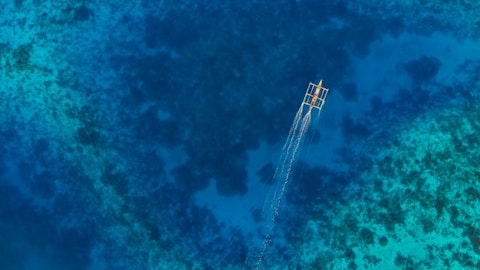We also have in fact one U.S. operator who is on the contract, and I cannot name that operator, in the last quarter they bought solutions for that market from us, and they’re Americans. They’re already aware that our solution is key for offshore renewables, and they are investing in the technology. So, I feel very much that’s a very big market for us. We do need to see the contractual hurdles that the Europeans have removed and I think they’re negotiating these. And we know that there are ongoing discussions on price resets. But I feel definitely excited about once those barriers are removed, the Echoscope is really at the heart of those operations’ infrastructure. So, anything underwater, make no mistake, anything underwater that involves placing something under the seabed, removing something from the seabed, navigating from point A to point B, that is the Echoscope.
That is the Echoscope and it’s the Echoscope wheelhouse. So, I feel very much that we have quite a lot of opportunities. They just need to — as I say, some of the macro factors need to be removed or normalized for us to move forward.
William Bremer: Okay, I understand. I hope that with the increase of SG&A, that some competent sales personnel will be hired for these markets given our infrastructure bill, given the amount of bridges that are needed, your technology will be welcome here. I just don’t see any tangibility on that front as of yet. My final question is on the Navy. And you have articulated much of the technology. When are we going to start to see a deployment of your technologies within a contract that portfolio managers like myself can get our hands on and start to really understand the magnitude of these contracts with the Navy and its allies?
Annmarie Gayle: I’m not sure I follow that question when you say when are we going to see. Could you be a little bit clearer? Sorry, Bill, I…
William Bremer: Yeah. I mean, we — I’m expecting — I think many of us have been for years have been expecting a deployment of your underlying technologies onto the U.S. Navy platforms. I’m just wondering when we’ll be able to understand which platforms they’re on and more importantly the longevity of those programs.
Annmarie Gayle: Well as soon as we are awarded one of the programs we’re talking about — look Bill, if I take about — if I talk about, for example, our ship hulls scanning comprehensive solution, that’s a multi-year program that we started four years ago. Four years ago from the feasibility, to the prototype concept, to finally developing the platform for ship hull scanning, we’ve delivered that. Now, that’s a sizable opportunity for the business and that runs over a number of years. So, look, evaluation under these programs can take up to four or five years, and some of the programs we’re on are more mature than others. But I think we’re making good progress. For example, this year, although we still haven’t received an order, this year, for example, a Japanese program that we’ve been working on for four years now, that Japanese program was launched and the Echoscope PIPE C500 is a part of that program.
So that now I understand that that vehicle is now being assessed and at sea with the end customer. So that’s how it all evolves. But I know it takes time, but it’s an area that we cannot afford and not to invest in heavily, because this is the opportunity for multiple recurring sales for our business. So, I think we’re doing the right things on doing the front end work to go out and get on these programs to ensure at least that we’re contenders. That’s the first thing. Know about the program, become contenders, support the programs, and we’re doing a lot of that, but that takes time, Bill. It is a — and that’s really where we will see the reward to grow. The commercial market, the profile of sale there, Bill, it’s one sale in a project. I just talked about an island being built.
If we get that order for five systems, then that’s exceptional in the commercial market because when there’s a project in terms of buying systems, the maximum system will be two systems and that can be a sizable, that would be around $700,000. But still, the point is that the opportunity to get multiples of sales and recurring sales comes from these programs, ship hull scanning programs, swimmer detection vehicles, mine countermeasure, critical asset management, these are all the programs that we are on. And also don’t forget, Bill, over the years, over 30 ports in the U.S. carry our underwater inspection system, including New York, including California, New Orleans. All of these, at one time or another, invested in our underwater inspection system for — if the President is coming in, it’s the Echoscope that’s used to sweep the port.





